Introduction
The unprecedented impact of Sagrada Família
Barcelona’s skyline is a symphony of architectural wonders, but none as soul-stirring and awe-inducing as Antoni Gaudí’s unfinished masterpiece, the Sagrada Família. Nestled in the heart of this vibrant city, this basilica stands as a testament to the genius of its creator and the indomitable spirit of artistic pursuit.
When one approaches the vicinity of this majestic structure, its soaring spires, intricate facades, and ethereal light immediately capture the imagination. It isn’t just another monumental structure; it’s a poetic blend of nature, spirituality, and architectural innovation.
For many, the first glimpse of the Sagrada Família is almost like encountering a mirage – an ethereal blend of stone, light, and faith rising mightily against Barcelona’s blue sky. The church’s cascading facades, intricate stonework, and symphonic play of stained-glass windows are unlike anything one has ever seen. This is not just the work of an architect but a labor of love, a legacy left behind by a genius that transcends epochs.
Gaudí, often hailed as the father of Catalan Modernism, poured his heart and soul into this project. Although he left us in 1926, his vision was so compelling that even today, almost a century later, artists, architects, and craftsmen are working diligently to realize his dream. Their work, coupled with the patronage of millions of visitors from across the globe, ensures that the basilica inches closer to its anticipated completion in 2030.
While Barcelona boasts a myriad of attractions – from the bustling La Rambla to the serene Barceloneta Beach – it’s the Sagrada Família that often leaves the most indelible impression. This isn’t just a building; it’s a narrative etched in stone and glass. Every facade tells a story, every pillar stands for a belief, and every arch symbolizes the boundless realms of imagination.
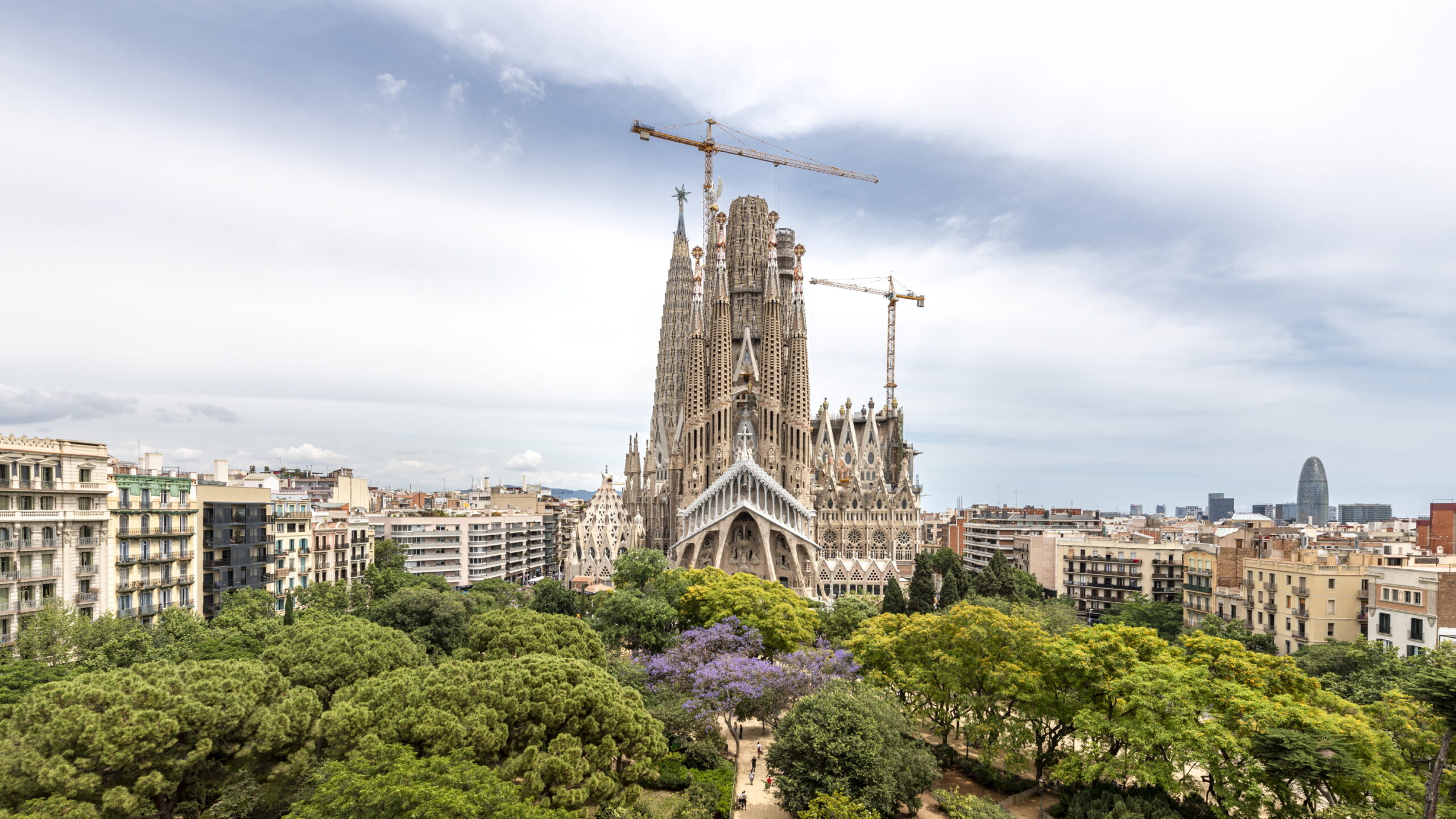
History of the marvel
Beginnings and evolution
When we delve into the historical tapestry of The Sagrada Família, the footprints of one genius become evident: Antoni Gaudí. However, the path leading to this timeless masterpiece is woven with threads of faith, passion, and boundless vision that transcends one individual.
Gaudí, profoundly influenced by the ideals of Catalan Modernism, always acknowledged the monumental scope and complexity of The Sagrada Família. He knew that its completion would stretch beyond his lifetime, necessitating the commitment and talents of subsequent generations. More than an architectural feat, Gaudí aspired to illustrate the evangelical message through the basilica, bearing witness to the Church’s omnipresence in the world.
Although Gaudí is often synonymized with this architectural marvel, the inception of Sagrada Família is deeply rooted in the devout intentions of Josep Maria Bocabella and Father Josep Manyanet, the visionaries behind this grand endeavor.
The origin of The Sagrada Família is often recounted with Bocabella’s 1871 pilgrimage to Rome and Loreto. But to understand its true beginnings, we must turn the clock back a bit. Bocabella, a staunch devotee of Saint Joseph, founded the Spiritual Association of Devotees of Saint Joseph in 1866 and initiated the magazine El Propagador de la Devoción a San José. Both endeavors aimed to seek Saint Joseph’s intercession for the Church. Concurrently, Father Manyanet, an advocate for families, drew inspiration from Bocabella’s endeavors. Their subsequent interactions and shared devotion paved the foundation for a monumental vision – to erect a national temple honoring Saint Joseph and the Holy Family.
Embracing Father Manyanet’s idea, Bocabella, upon his return from Loreto in 1871, sought to bring this vision to life. Thus, on December 31, 1881, he procured a vast 12,800 m² plot in the then-town of Sant Martí de Provençals, within Barcelona’s modern Eixample district. The intention was clear: to erect an expiatory temple – a sanctuary built solely from the donations of believers, aiming to atone for humanity’s transgressions.
The initial blueprint was placed in the hands of the diocesan architect, Francisco de Paula del Villar. However, disagreements with Bocabella led to a change in stewardship by 1883. Enter a young, visionary architect: Antoni Gaudí. Over the years, Gaudí proposed a more audacious plan, both in construction and symbolism. He even envisioned the temple’s surrounding environment, submitting proposals to the city council in 1916.
In essence, The Sagrada Família is not just an embodiment of Gaudí’s brilliance but a culmination of shared dreams, enduring faith, and a collective commitment to celebrate divinity through architectural grandeur.
A testament to the city’s spirit
The Sagrada Família stands as a beacon of hope, spiritual inspiration, and architectural innovation in the heart of Barcelona. It’s not merely a structure but a testament to Barcelona’s unyielding spirit, a masterclass in architectural prowess, and a symbol of unwavering faith.
“La Basílica es un gozo del espíritu, y todos los que entran en ella encuentran un nuevo sentido a la vida.” This radiant church, the Sagrada Família, encapsulates the Christian faith in stone. Those of Christian belief will find its interiors echoing the tenets of their faith, while non-believers or those of different religions will grasp the foundational pillars of Christianity. With an architecture deeply imbued with symbolism, every brick and beam speaks of a monotheistic God – The Father, Son, and Holy Spirit.
Antoni Gaudí’s magnum opus reveals the mystery of the Trinity. Soon, on the main façade, known as the Glory façade, passersby will witness the words: “credo in unum deum“. This Latin phrase translates to, “I believe in one God,” a summary of Christian and Catholic faith, the very faith that Gaudí devoutly believed in until his last breath.
Distinct from other churches, the Sagrada Família is both traditional and innovative. While it retains the primary purpose of celebrating the Eucharist, its architectural choices, particularly the altar, set it apart. The altar, symbolizing Jesus Christ’s sepulcher, is the heart of this basilica. While the structure maintains the iconic cross shape seen in many Christian churches, the placement of significant moments from Christ’s life at the ends of the cross-arms makes it unique. The three facades represent His birth, His passion, death, resurrection, and His glory.
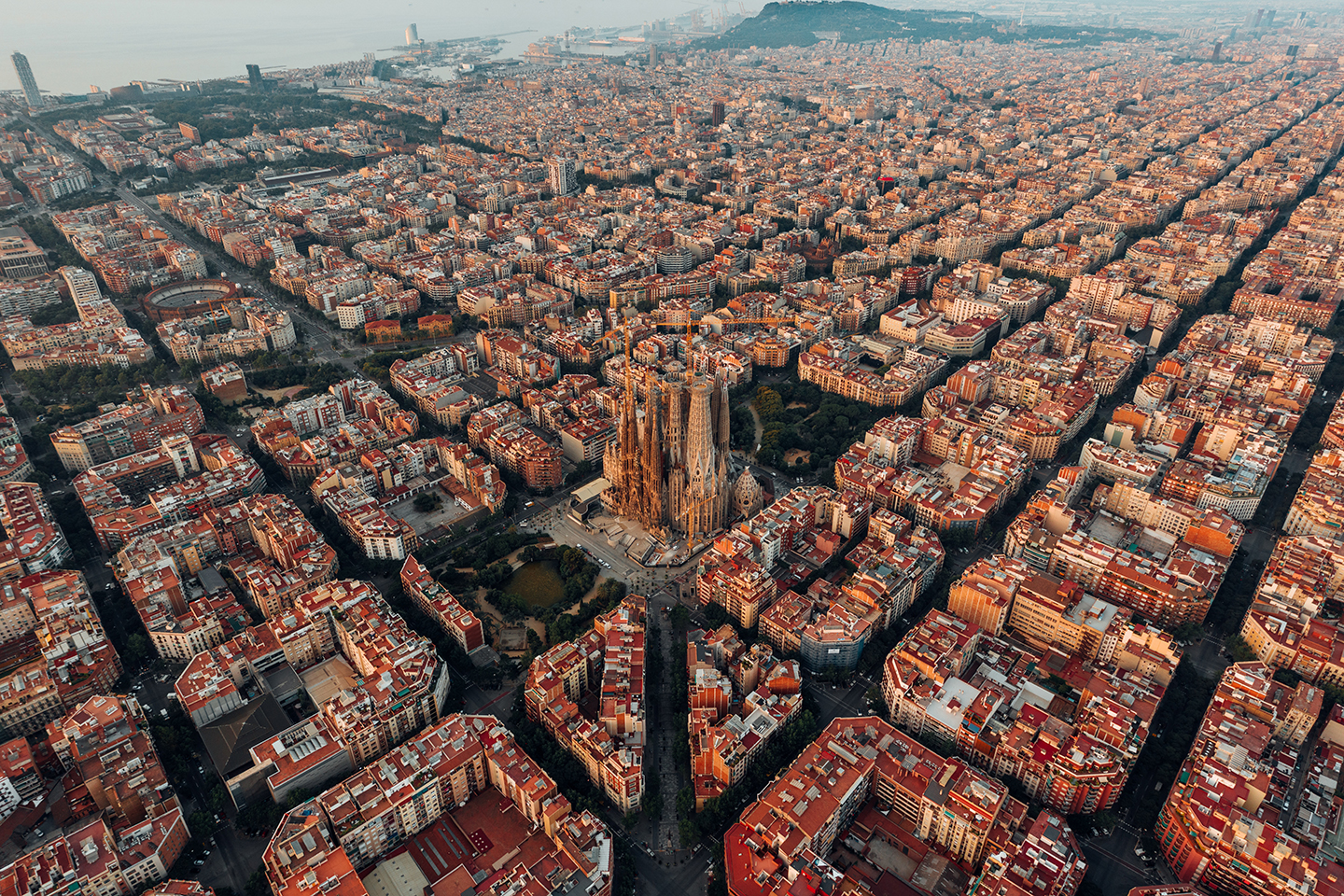
The apse at the top end of the church is a celestial representation. It pictures God as the creator of the universe, flanked by the Son and the Holy Spirit. But this isn’t the only symbolism. The towers, often considered merely ornamental in many churches, bear a weighty significance in Gaudí’s design. They symbolize Jesus Christ at the center, surrounded by the four Gospels, His mother Mary, and the twelve apostles, portraying the foundational figures of Christianity.
Inside the Basilica, Gaudí achieved splendor solely through architecture and light. He envisioned an interior reminiscent of a forest. The stone seems to sing the divine glory, reflecting the beauty of creation. Gaudí’s dream was for the Basilica to host grand liturgical celebrations, with voices rising to the heavens, harmonizing with the resonating organs, and being enveloped in the ethereal scent of incense. For Gaudí, the Sagrada Família wasn’t just another church. It was a slice of heaven on Earth.
In essence, the Sagrada Família isn’t just about its mesmerizing towers or intricate facades. It’s about a city’s spirit, a testament to unwavering faith, and the timelessness of architectural beauty. It stands, generation after generation, as Spain’s timeless jewel.
Modernism in Barcelona: the rise and influence of the art movement
Barcelona, a city teeming with history and culture, is perhaps most celebrated for its contributions to the Art Nouveau movement, known locally as Modernisme. This style, which flourished in the late 19th and early 20th centuries, boasts a legacy of artistic brilliance that still resonates throughout the city’s streets, landmarks, and edifices. At the heart of this movement stands a name synonymous with architectural genius: Antoni Gaudí. His most celebrated work, the Sagrada Família, is a testament to the indomitable spirit of Modernism and its deep-rooted influence in Barcelona.
You can also visit this article on Modernism in Barcelona.
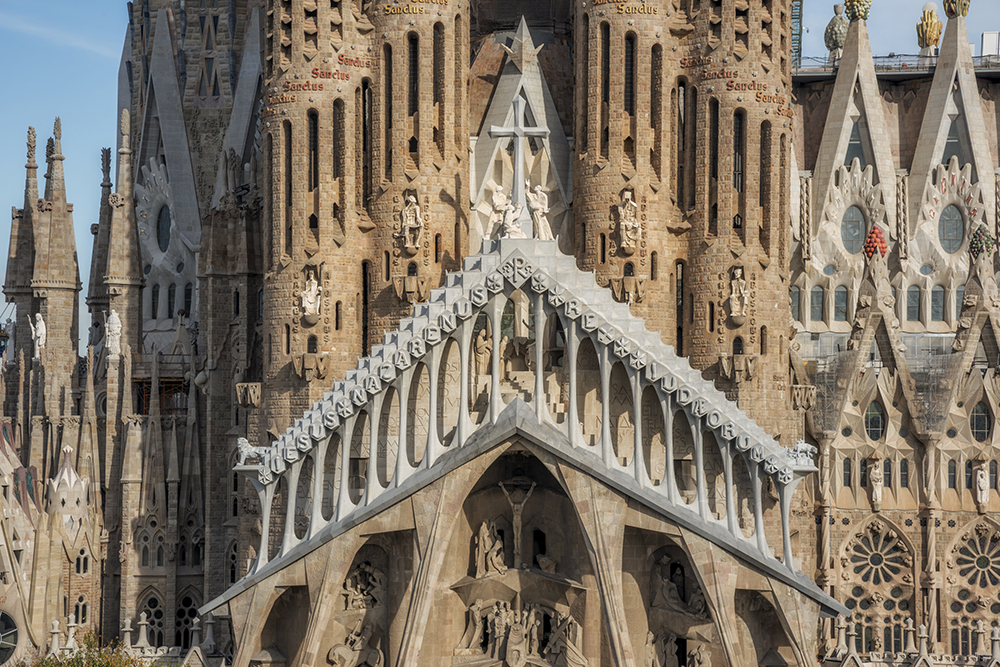
The birth of Modernism
In the late 1800s, as industrialization rapidly transformed the European landscape, Catalonia underwent a cultural renaissance. Catalans yearned for a distinct identity, setting them apart from the rest of Spain. In this socio-political backdrop, Modernisme was born. Not merely an artistic trend, it was a movement that encapsulated the aspirations of a people.
Renowned institutions like the Cercle Artístic de Sant Lluc and the Liceu Escola d’Art (both active hubs for artists) became the epicenters of this revolution, enabling artists, architects, and craftsmen to challenge conventional norms and explore avant-garde concepts.
Gaudí and the Sagrada Família: an embodiment of Modernism
No discussion of Modernisme can be complete without mention of Antoni Gaudí. While many talented architects like Lluís Domènech i Montaner and Josep Puig i Cadafalch made significant contributions, it was Gaudí who became the movement’s poster child.
The Sagrada Família, started in 1882 and still under construction, stands as a metaphor for the enduring spirit of Modernism. Its majestic spires, intricate facades, and symbolic sculptures capture the essence of Modernisme: a harmonious blend of nature, religion, and local tradition.
Gaudí’s meticulous attention to detail and innovative use of materials and techniques transformed the project into more than just a basilica. It became a canvas illustrating Catalonia’s rich tapestry of history, culture, and aspiration.
Influence beyond architecture
Modernisme was not confined to the realm of architecture. The movement left its mark on a wide array of disciplines, from painting and sculpture to decorative arts and literature. Artists like Ramon Casas and Santiago Rusiñol, through their masterpieces, reflected the ethos of Modernisme – a fusion of old-world charm and new-age dynamism.
Barcelona’s famous Passeig de Gràcia showcases the architectural treasures of this period. The vibrant tiles that adorn the pavement, designed by Josep Puig i Cadafalch, are a nod to the movement’s affinity for nature-inspired motifs.
A timeless legacy
Today, Modernisme is celebrated not just as an artistic movement but as a symbol of Barcelona’s indomitable spirit. The city’s Modernista Route (www.rutadelmodernisme.com) allows tourists and enthusiasts to embark on a journey, tracing the footsteps of the legends who shaped this epoch.
As we stand in the shadows of the towering Sagrada Família, we are reminded of the power of art and vision. The basilica, despite being unfinished, is a timeless jewel, a beacon of inspiration, and a testament to the eternal beauty of Modernism in Barcelona.
Antoni Gaudí: the visionary behind the dream
Life, influence, and legacy
Antoni Gaudí, a name that is synonymous with Barcelona’s architectural landscape, is celebrated globally for his audacious and unparalleled designs. Born in the Catalonia region of Spain in 1852, this architectural genius would grow up to reshape the face of Barcelona and, by extension, the realm of modernist architecture.
Early life and education
Gaudí’s love for architecture blossomed early, fueled by the rich landscapes of Catalonia. These natural forms, with their curvilinear beauty, would later serve as inspirations for his designs. Enrolling at the Barcelona Architecture School, Gaudí’s uniqueness was evident. While some instructors deemed him a dreamer, others recognized his prodigious talents.
A new architectural language
Upon graduating, Gaudí embarked on projects that began to challenge and reshape the architectural norms of the time. He amalgamated nature, spirituality, and innovation to create what can only be described as living sculptures. Traditional bricks and mortar structures were transformed into undulating surfaces, intersecting geometries, and a fantastical play of light and shadow.
Nowhere is this more evident than in his magnum opus, the Sagrada Família. What started as a conventional neo-Gothic church in 1882, soon transformed under Gaudí’s direction into a masterpiece that encapsulated his entire architectural philosophy. From the spiraling nativity façade to the stunning interiors resembling a stone forest, the Sagrada Família is a testament to Gaudí’s unbridled imagination.
Influence and collaborations
Throughout his career, Gaudí collaborated with various artisans, sculptors, and architects. These collaborations further expanded his repertoire, allowing for the incorporation of mosaic works, stained glasses, and wrought ironwork into his structures. Casa Batlló and Park Güell, both UNESCO World Heritage sites like the Sagrada Família, showcase the beautiful symphony between Gaudí’s vision and his collaborators’ expertise.
For those wanting to delve deeper into Gaudí’s methods and influences, the Gaudí Exhibition Center in Barcelona offers a comprehensive insight (www.gaudiexhibitioncenter.com).
Legacy
Tragically, Gaudí’s life was cut short in 1926 following an accident. However, his architectural legacy endures. Beyond the structures, Gaudí left behind a school of thought, emphasizing organic forms, innovative materials, and a profound respect for nature.
The Sagrada Família, still under construction, serves as a poignant reminder of his genius. A dream so expansive that it transcends generations of architects and craftsmen dedicated to its completion.
Conclusion
Antoni Gaudí, a visionary who dared to dream beyond the conventional, has gifted Barcelona, and the world, with architectural wonders that remain timeless. While buildings may age, the genius of Gaudí, especially as embodied by the Sagrada Família, remains as fresh and awe-inspiring as the day the first stone was laid.
You can also visit this article on Modernism in Barcelona for a broader understanding of the movement that shaped Gaudí’s era.
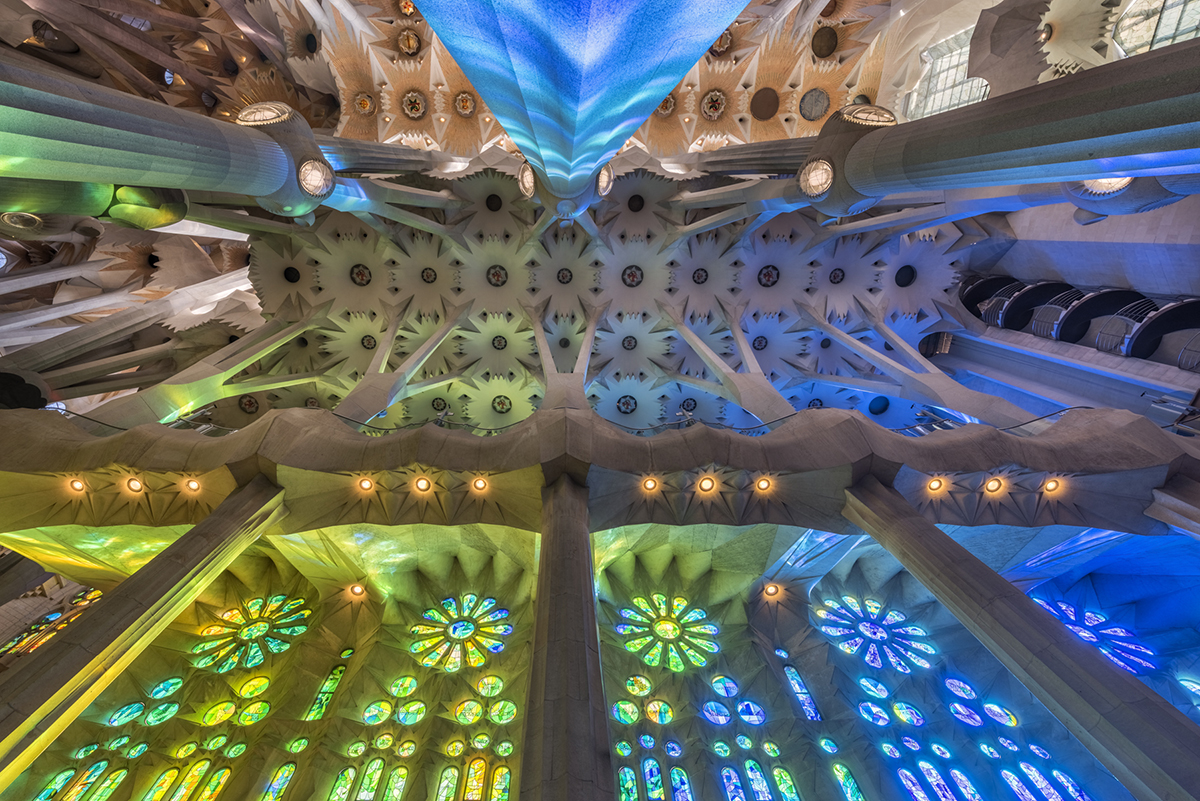
Gaudí’s Architecture of the Sagrada Família
Antoni Gaudí, the maestro of Catalan modernism, redefined and enhanced classic styles, particularly the Gothic, crafting a novel architectural language. Although multiple architects have contributed to the Sagrada Família, its indelible stamp is unmistakably Gaudí’s. The Sagrada Família is his magnum opus, absorbing 43 years of his professional life. His dedication can be seen in every intricacy, every spire, and every mosaic. Even though he personally oversaw just a fragment of the construction, Gaudí left a comprehensive roadmap with sketches, models, and clear directives.
Gaudí envisioned the church echoing the grandeur of Gothic and Byzantine cathedrals. Yet, he went beyond. Incorporating the discipline of classic Greek architecture in the columns’ proportions and arrangements, he revamped traditional styles, presenting something fresh. His innovative use of geometry carved unprecedented forms, giving the temple its unmatched distinction. Nature, a perpetual muse for Gaudí, can be discerned in the Sagrada Família’s harmonious structures and seamless surfaces, always in pursuit of beauty and optimal liturgical function. Indeed, throughout the edifice, architectural forms intertwine seamlessly with symbolism.
General profile
The Sagrada Família’s silhouette is not birthed from architectural principles alone; it’s steeped in transcendent symbolism. Initially conceived by architect Francisco de Paula del Villar y Lozano, the Basilica’s design is cross-shaped, reminiscent of Gothic architecture. It boasts three monumental facades, each a testament to its grandeur. Gaudí proposed a cluster of eighteen soaring towers, their hierarchy reflecting the deep symbolism embedded in their design.
Positioned grandly across the three facades are monumental narthexes, distinct for each. The entirety is complemented by four dome-like structures, roughly forty meters in height, placed at the corners. Amidst this splendor, Gaudí’s proposed cloister will serve as a sanctuary, offering a serene space for processions, contemplation, and introspection.
Structure and shapes
Gaudí’s genius lies in his ability to abandon conventional architectural elements, replacing them with features that infused his work with elegance and brilliance. The Sagrada Família showcases balanced structures, efficiently channeling weights to the foundations. The utilization of geometric shapes in Gaudí’s later phase is evident, blending seamlessly with his architecture’s organic feel.
The light and color
Natural light harmoniously dances throughout the temple, an intentional design element by Gaudí. It adds splendor and vitality to his creations. Beyond the exquisite stained-glass windows, Gaudí passionately believed in the expression of life through color. It permeates the Sagrada Família, from the rich hues of the façades to the trencadís of Venetian glass.
Materials and construction techniques
Often overlooked, an intriguing facet of the Sagrada Família is Gaudí’s adoption of cutting-edge construction techniques and materials of his time, notably reinforced concrete. While the materials mirror Gaudí’s original choices, what sets them apart is the contemporary technological prowess applied during the construction.
In essence, the Sagrada Família stands as an everlasting testament to Gaudí’s brilliance, creativity, and unwavering devotion. It is not just a building; it is Spain’s timeless jewel.
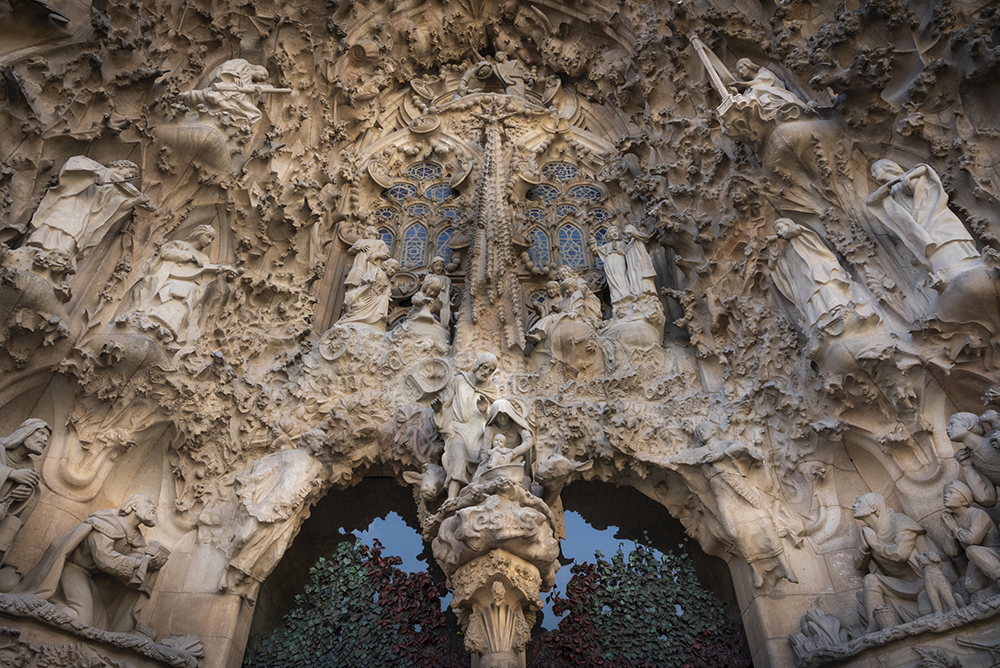
Top 10 features of Sagrada Família
1. La Fachada del Ábside
Often overshadowed by the more renowned facades of the Sagrada Família, the Fachada del Ábside is a lesser-known but equally significant gem in Gaudí’s masterwork. This facade, seamlessly blending elements of neogothic architecture with distinct Gaudinian touches, serves as a pivotal transition point in the Basilica’s evolution.
Constructed between 1890 and 1893, the facade offers profound insights into the architectural metamorphosis from Francisco de Paula del Villar’s initial neogothic design to the revolutionary approach of Antoni Gaudí. Although the unmistakable Gaudinian architecture prominently adorns other parts of the Sagrada Família, at this juncture, it was still in its nascent stages. Bit by bit, Gaudí incorporated both structural and ornamental elements, subtly layering his influence over the groundwork laid by the diocesan architect.
Interestingly, while most constructions proceed from the foundation upwards, Gaudí flipped the script. He believed in completing certain sections of the temple first to hinder potential future halts in construction. While he had initially planned to construct the entirety of the apse post its facade’s completion, he pivoted to raise the Fachada del Nacimiento (Nativity Facade) next. This strategic move ensured that subsequent architects would continue his life’s work. The Fachada del Ábside stands as the only facade Gaudí saw to completion in his lifetime.
Gaudí’s touch on the Ábside
Adhering to architect Del Villar’s original blueprint, the Fachada del Ábside features a polygonal apse complemented by seven apsidal chapels. A distant gaze reveals Gaudí’s unconventional treatment for the period, demonstrating his intent for the temple’s overall pyramid-like structure.
Six buttresses, distinguishing the chapels, ascend to sharp, nearly 50-meter high spires. These spires are adorned with flora motifs – inspired by the wild plants that once thrived around the Sagrada Família construction site. Flower buds cap the spires of the apse’s staircase, and each chapel boasts three windows, further segmented by buttresses and lower spikes, all crowned with grain motifs. Gaudí strategically positioned a base and a canopy atop the taller buttresses, leaving room for statues of religious order founders.
To date, statues of saints like San Benito, San Antonio Abad, San Bruno, Santa Clara, San Bernardo, and Santa Escolástica have found their homes here. Works of noted artists like Manuel Cusachs, Montserrat Garcia Rius, and Francesc Fajula enhance the facade’s majesty. Additionally, depictions of San Francisco de Asís and Santa Teresa de Jesús grace the windows closest to the Fachada del Nacimiento and Fachada de la Pasión.
In essence, the Fachada del Ábside of the Sagrada Família is not just an architectural marvel but a testament to Gaudí’s vision and Spain’s rich heritage. For those fortunate enough to wander the basilica’s hallowed grounds, it remains a serene, often overlooked, portal into Gaudí’s genius.
Symbolism of the Ábside facade
Antoni Gaudí, in his unyielding quest to mirror nature, ensured that the Fachada del Ábside was teeming with nods to the Mediterranean fauna, particularly drawing inspiration from creatures that once inhabited the very grounds where the basilica now stands.
Prominently, figures of both terrestrial and marine snails, lizards, frogs, toads, and snakes were intricately incorporated. Gaudí, ever the innovator, transformed these representations into functional gargoyles designed to channel rainwater from the Ábside’s rooftop.
However, to discuss the Fachada del Ábside without noting its spiritual symbolism would be an oversight. Echoing the very essence of the Sagrada Família, atop the pointed apex of the trilobate arches present above each of the three windows of every apsidal chapel, one can discover monograms representing Jesús, María, and José. This meticulous attention to detail underscores Gaudí’s dedication to infusing spiritual significance into every facet of his architectural marvel.
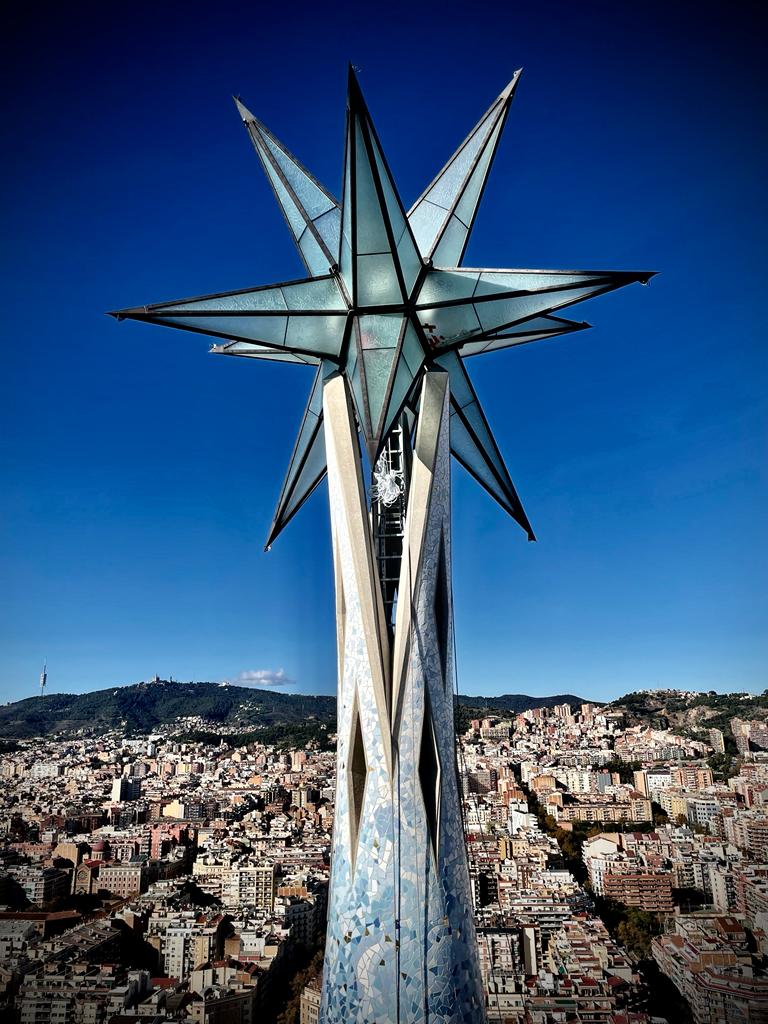
2. Nativity Façade: a tribute to nature’s splendor
The Sagrada Família, Gaudí’s eternal tribute to divinity, is perhaps most breathtakingly epitomized in its Nativity Façade, a magnificent paean to the splendor of life and nature.
Bold beginnings
The Nativity Façade celebrates the joy of Jesus’s birth. It’s the very first façade constructed under Gaudí’s meticulous supervision, every architectural, ornamental, and symbolic detail was overseen by him. Facing the east, on Calle de la Marina, this façade mirrors the temple’s transept. It narrates the birth of Jesus – an encapsulation of life’s joy and wonder.
Nature’s celebration
As a testimony to life’s exuberance, Gaudí ensured this façade was a grand homage to every living being in nature. In fact, it’s rife with detailed representations of animals (shells, hens, diverse birds, ducks, eagles, etc.) and botanical motifs (roses, almond trees, cherries, lilies, passion flowers, and more). Such is the depth of detail that sculptures were molded using real-life human and animal models. Gaudí then placed the plaster models on the façade, verifying their appearance before final stone carving.
Intricate Structure
Every element of this façade is symbolic. It showcases three portals representing the Holy Family. Crowned by four bell towers transitioning from square to circular sections, the façade’s intricate elements make it truly unique. Central to the façade, encrusted with icicle-like features symbolizing the chill of Christmas, are the three grand portals. Each one ends in a symbolic pinnacle: a cypress for the central portal, a rock from Montserrat mountain on the seaside, and eucharistic spikes on the mountainside – symbolizing God’s omnipresence and omnipotence.
Façade of the Transept
This section revolves around Christmas and Jesus’s childhood. With the grand portals dedicated to theological virtues of Hope, Charity, and Faith, the façade also features angels, trumpeting the birth of Jesus, resting on turtle-backed columns. Each portal is adorned with rosary beads, celebrating Jesus’s life and teachings.
Portal of Charity
The central portal is a celebration of Jesus. Various sculptural assemblies depict the life events of Jesus, right from the Annunciation to his birth in Bethlehem. Notably, the Nativity and Annunciation groups were sculpted by Jaume Busquets, while Joaquim Ros i Bofarull crafted the Adoration scenes.
Portal of Hope
Dedicated to Joseph, this portal celebrates him as Jesus’s earthly father and protector of the universal Church. It portrays various significant events, including the marriage of Mary and Joseph and their escape to Egypt.
In Summary
The Nativity Façade of the Sagrada Família is a mesmerizing blend of architecture and symbolism, a fitting tribute to Gaudí’s genius and his dedication to expressing divinity through art. Every stone, every sculpture, and every detail sings a harmonious song of life, nature, and the divine, inviting every visitor to pause, reflect, and marvel.
3. Passion Façade: depicting the ultimate sacrifice
If the Sagrada Família is a book of architectural wonders, the Passion Façade is its most heart-rending chapter. Designed to evoke strong emotions, it encapsulates the pain, sacrifice, and intense passion of Jesus’s last days.
Sculptural narration
Unlike the ornate and whimsical nature of the Nativity Façade, the Passion Façade is stark, rigid, and intense. Sculptor Josep Maria Subirachs embraced a more modernist approach in this section, ensuring each sculpture tells a story. As you walk closer, you’ll notice scenes from the Last Supper, the Betrayal of Jesus, and the Crucifixion.
Angular forms
A defining feature of this façade is its angular forms – purposefully chosen to reflect the severity and anguish of Christ’s passion. These angles cast ominous shadows during sundown, adding a depth and an added layer of storytelling to the beholder.
Four bell towers
Ascending high into the Barcelona skyline are the four bell towers of the Passion Façade, dedicated to the apostles James, Thomas, Philip, and Bartholomew. Visitors (with a head for heights) can ascend these towers and be treated to a panoramic view of Barcelona (Official Tours).
Bronze doors
One of the standout elements of this façade is the massive bronze door. Inscribed on them are passages from the Bible, primarily the books of Matthew and John, creating a textual narrative that complements the sculptural tales on the façade.
Magic square
An element that often piques the curiosity of visitors is the 4×4 grid, known as the Magic Square. Each row, column, and diagonal sums up to 33, the age of Jesus at his crucifixion. A mathematical wonder, it’s a testament to the intricate details that define the Sagrada Família.
Bridge between towers
Connecting two of the bell towers is a bridge. Besides its architectural functionality, it offers a unique vantage point for photographers and onlookers, capturing the magnificence of Barcelona and the basilica’s intricate spires.
Presence of Judas
The Passion Façade boldly features the figure of Judas betraying Jesus with a kiss. It’s a reminder of the tragic tale of betrayal that’s central to the Passion’s narrative.
Porch of Sanedrin
Below the façade is the porch of Sanedrin. Supported by six large columns, it provides shelter and features scenes of Jesus’s trial.
Subtle symbols
Like every part of the Sagrada Família, the Passion Façade is replete with symbolism. From the cockerel that crowed after Peter’s denial to the veiled Veronica with Jesus’s face imprinted on her veil – the symbols prompt a deeper introspection of the Passion story.
Ongoing restoration
While Gaudí’s vision has largely been realized, restoration and preservation efforts continue to ensure that this masterpiece stands the test of time. Organizations like the Fundació Junta Constructora del Temple Expiatori de la Sagrada Família work tirelessly to maintain and enhance this global icon.
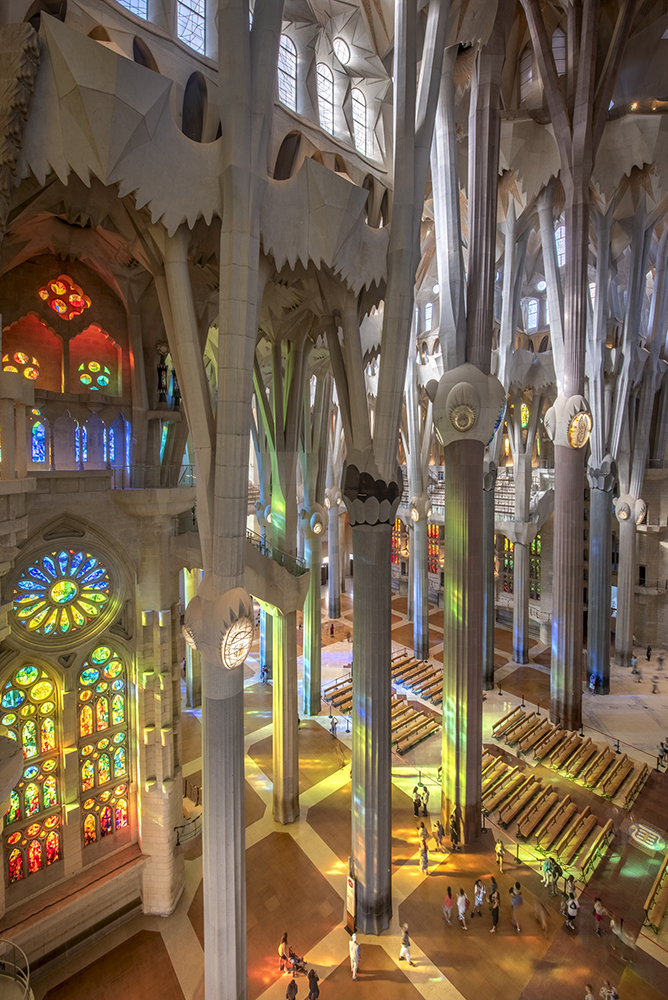
4. Spiral Staircases: ascending in whimsy
The heart of Barcelona is home to many wonders, but none quite as mystifying or as grand as Antoni Gaudí’s Sagrada Família. While the basilica’s towering spires and intricate facades often take center stage in photographs and travelers’ memories, there exists within its walls a more subtle beauty, an architectural detail as mesmerizing as it is functional: the Spiral Staircases.
At first glance, the spiral staircases within the Sagrada Família might appear to be just another beautiful detail in a structure teeming with ornate design. However, a closer examination reveals that they are so much more than decorative. They are, in essence, an ode to the very fabric of life and the universe.
Spirals are a recurring theme in nature. From the delicate coil of a seashell to the expansive arms of galaxies, this shape is ubiquitous, representing growth, evolution, and continuity. Gaudí, ever the observer of nature, did not merely seek to replicate this form but to elevate it. He envisioned the staircases not only as a way to move between levels but as a journey from the terrestrial to the celestial.
In designing these staircases, Gaudí showcased his unparalleled ability to blend form and function. As visitors begin their ascent, they are greeted by a sense of whimsy, an invitation to let go of the mundane and embrace the extraordinary. Each step, meticulously crafted, offers a rhythmic progression, with the surrounding walls curving gently to guide the climber upwards. The journey through these spiraled paths becomes a meditation, a dance between the human spirit and the architectural marvel that surrounds it.
The play of light is another captivating aspect of the experience. As one ascends, the staircase seems to come alive, with sunlight filtering through the intricate stonework, casting dynamic shadows that ebb and flow with the time of day. This interplay of light and shadow adds an ethereal quality to the ascent, making each step feel like a movement through a dream.
But beyond the physical and aesthetic appeal, the spiral staircases are a testament to Gaudí’s belief in the interconnectedness of all things. The repetitive looping pattern speaks to cycles, to beginnings and endings that are eternally linked. Just as life is a continuous journey of growth and transformation, so too is the experience of moving through these spirals, reminding visitors of the ever-present connection between the earthly and the divine.
Moreover, there’s a universality in the design. No matter one’s background, beliefs, or life experiences, the sensation of ascending through these staircases evokes a shared human emotion. It’s a feeling of wonder, a recognition of the beauty in details, and an acknowledgment of the vastness of the universe.
5. Spires: gargoyles and mosaics overlooking the city
In the heart of Catalonia’s vibrant capital, Barcelona, Antoni Gaudí’s Sagrada Família stands as a beacon of art, faith, and human imagination. Rising majestically from the city’s bustling streets, the basilica’s Spires command attention, reaching skyward in an act of architectural and spiritual elevation. But it’s not just their towering heights that mesmerize; it’s also the intricate details that adorn them: a harmonious blend of gargoyles and mosaics, each telling a story, each connecting the terrestrial to the celestial.
The decision to grace the spires with gargoyles was not merely aesthetic. Gargoyles, historically, are deeply rooted in religious architecture, often serving dual purposes: as functional water spouts and symbolic guardians. These stone sentinels, with their sometimes grotesque appearances, were believed to ward off evil spirits. Gaudí’s gargoyles are no different. Perched high above the city, they stand watch, their stone eyes gazing protectively over Barcelona, ensuring the sanctity of the space they guard.
Yet, Gaudí’s gargoyles are also reflective of his love for nature and his ability to draw inspiration from the world around him. Modeled after local fauna, they encapsulate the essence of Catalonia’s biodiversity, showcasing creatures from the region’s mountains, forests, and shores. This interplay between the sacred and the natural underscores Gaudí’s belief that divinity can be found in nature’s details.
Complementing these watchful guardians are the shimmering mosaics. Inspired by the play of sunlight on Barcelona’s Mediterranean waters, Gaudí incorporated colorful tiles that catch and refract light, making the spires gleam brilliantly under the Spanish sun. But the mosaics are not just about capturing light; they are about capturing life’s essence. From a distance, they might seem like mere decorative elements, but a closer look reveals intricate patterns and designs, each representing themes from Christian theology and Catalan culture.
The juxtaposition of gargoyles and mosaics creates a dynamic visual dialogue. While the gargoyles represent the protective and earthly aspects, the mosaics, with their radiant beauty, speak of the heavens, of divinity, and of the promise of eternal light. This duality reflects the human journey, grounded in earthly experiences but always reaching, aspiring for the divine.
As one raises their gaze to the top of these spires, there is a palpable sense of ascension, not just architecturally but also symbolically. The spires, with their apexes piercing the heavens, represent humanity’s constant yearning to connect with the divine, to understand the mysteries of existence, and to find meaning in the vast cosmos.
Moreover, these spires offer a panoramic vantage point. From their summits, the entirety of Barcelona sprawls out, a tapestry of history, culture, and modernity. This perspective not only amplifies the connection between the Sagrada Família and the city it calls home but also symbolizes the nexus between the material and spiritual realms.
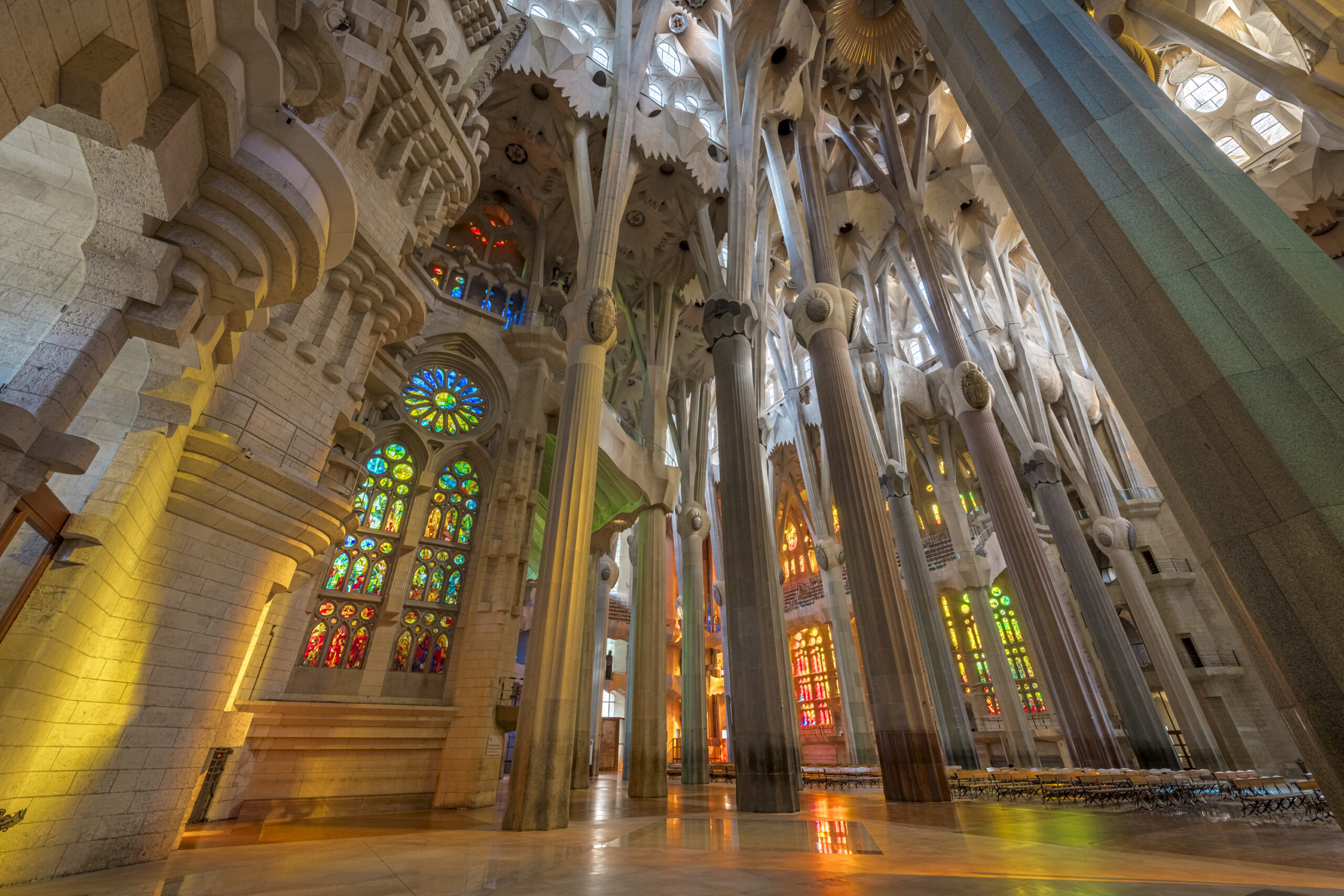
6. Hanging model: Gaudí’s architectural prowess
Within the pantheon of great architects, Antoni Gaudí occupies a unique position, revered not only for his avant-garde aesthetics but also for his revolutionary approach to structural engineering. A shining testament to his genius is his employment of the Hanging Model—a groundbreaking method that changed the course of architectural design, underscoring his forward-thinking vision.
Instead of the traditional blueprints and sketches most architects of his time relied upon, Gaudí looked to the natural world and physics for inspiration. Recognizing that nature inherently knows how to distribute forces—like the branches of a tree or the veins in a leaf—Gaudí sought a means to replicate this organic wisdom in his designs. His solution? An upside-down model of the Sagrada Família, built using strings and weights.
The principle behind the Hanging Model is deceptively simple, yet its implications are profound. By creating a suspended, inverted model of his architectural vision, Gaudí could observe how the strings (representing columns and arches) naturally adjusted under the pull of gravity. The weights attached at various points simulated the forces the actual structure would need to bear. As gravity pulled these weights down, the strings would form parabolic curves, showcasing the most efficient and stable pathways for distributing architectural stress.
This intuitive approach offered Gaudí real-time insights into structural optimization. Rather than relying on extensive mathematical calculations, the Hanging Model provided a visual representation of how forces would interact within the Sagrada Família. By studying these natural catenary curves formed by the strings, Gaudí could then determine the precise angles and positions for the basilica’s pillars and arches, ensuring they would bear the weight of the structure efficiently and safely.
The brilliance of this method lies in its embodiment of Gaudí’s philosophy—that architecture should mirror the organic logic and harmony of nature. Just as a spider’s web or a stalactite naturally forms in response to gravitational forces, the Sagrada Família, guided by the Hanging Model, would rise with an intrinsic understanding of weight and balance.
In an era where architectural failures were not uncommon, Gaudí’s dedication to structural integrity—combined with his unparalleled aesthetic vision—set him apart. The Hanging Model was more than just a tool; it was a testament to his belief that the answers to humanity’s most complex problems could often be found in the natural world.
Today, as visitors marvel at the towering spires and intricate facades of the Sagrada Família, they witness not only a masterpiece of art but also of science and engineering. The basilica stands as an enduring tribute to Gaudí’s innovative spirit, and the Hanging Model, though less visible, remains a vital component of his legacy—a testament to the boundless possibilities when creativity meets understanding.
7. Nave: a majestic stone forest
When one enters the Sagrada Família, it’s easy to be overwhelmed by its external grandeur and the profound intricacy of its façades. However, the true essence of Gaudí’s genius unveils itself in the heart of the basilica: the Nave. Here, visitors are enveloped in a scene that fuses architecture with nature, creating a sanctuary that feels both timeless and divine.
Gaudí’s vision for the Nave was unlike any other cathedral or basilica of his time. Rejecting the conventional pillars and arches, he drew inspiration from the woods and forests of his beloved Catalonia. In place of straight, rigid columns, the Nave boasts towering structures that resemble trees, with their bases rooted firmly in the ground, and their upper sections branching out, reaching for the heavens. This ingenious design not only lends an ethereal quality to the space but also serves a functional purpose. The branched columns distribute weight more evenly, allowing for a more open and airy interior.
The experience of walking through the Nave is akin to a stroll through a dense forest at dawn. Sunlight filters through the intricate stained-glass windows, creating a mosaic of colors that dance across the stone floor. Blues, reds, yellows, and greens play in harmony, mirroring the dappled sunlight one might witness in a woodland glade. This intentional use of light is not mere spectacle; it symbolizes the divine light of God, shining its grace upon the faithful.
The ceiling of the Nave further intensifies this forest-like ambiance. The “leaves” of the stone trees form a complex canopy overhead, with hyperbolic shapes and patterns reminiscent of nature’s fractals. Gaudí’s keen observation of nature is evident in every crevice and curve, highlighting his belief in the deep connection between the natural world and the spiritual realm.
Sound, too, plays a pivotal role in the Nave’s ambiance. The unique architecture enhances acoustics, making hymns and prayers resonate in a way that seems to echo the harmonies of the universe. The very stone seems to sing, with every corner, every alcove, resonating with the collective spirituality of centuries.
To be in the Nave of the Sagrada Família is to be at the crossroads of the earthly and the divine. It stands as a testament to Gaudí’s belief that God’s grandest temple is nature itself, and through his architectural prowess, he brought that temple indoors. Today, as thousands of visitors traverse this majestic stone forest, they are reminded of the timeless dance between light and shadow, between the tangible and the ethereal, and between mankind and the divine.
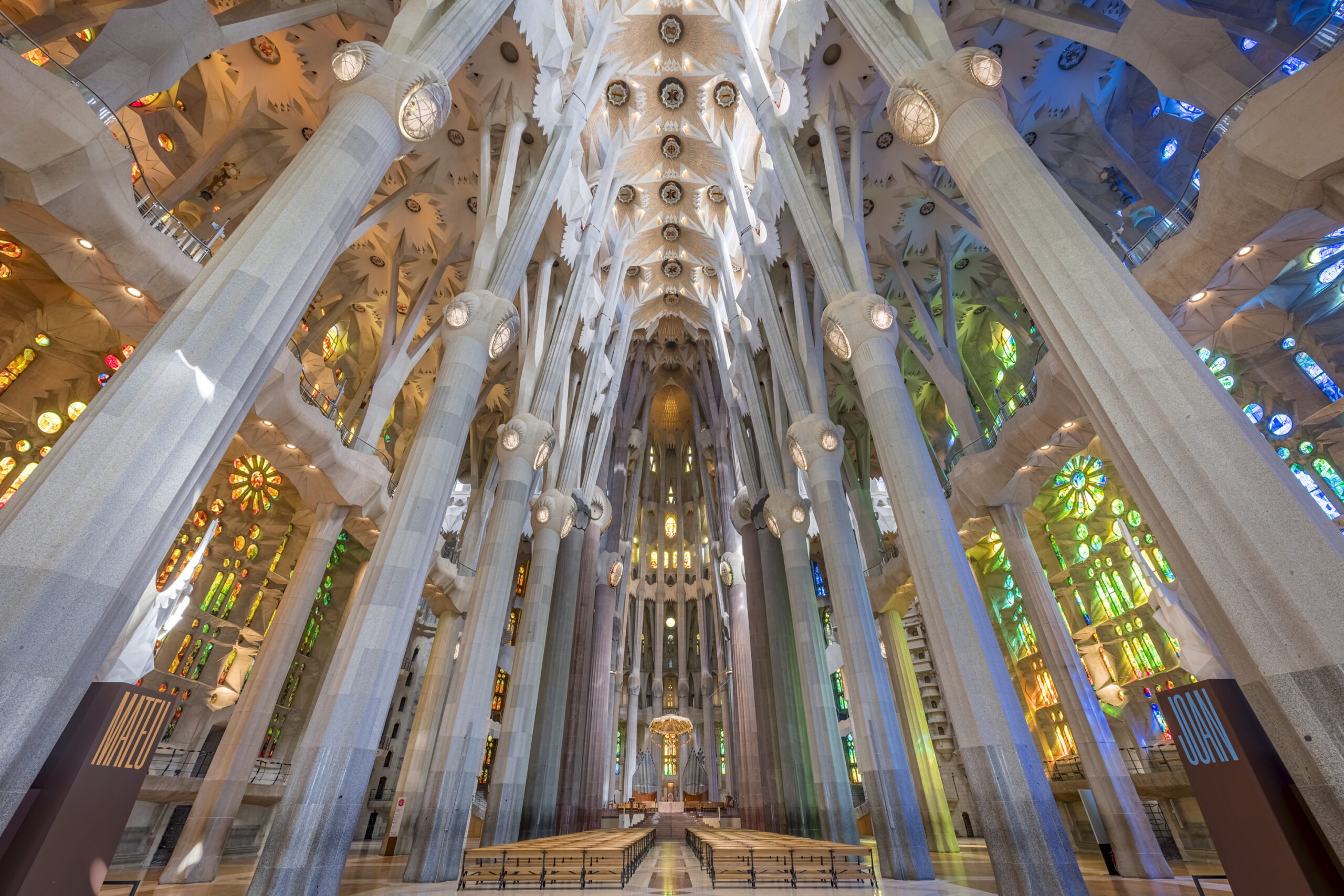
8. Rosedoor Cloister: a blend of tradition and modernity
Nestled amidst the imposing and awe-inspiring edifices of Gaudí’s Sagrada Família, there’s a space that elegantly marries the past and present, the traditional and contemporary: the Rosedoor Cloister. This lesser-known gem, often overshadowed by the basilica’s grander elements, offers a profound experience for those in search of tranquillity and a connection to the timeless.
In traditional architecture, cloisters are typically enclosed spaces, often associated with religious buildings, offering a place for contemplation and reflection. They serve as a bridge between the outer world of bustling activity and the inner sanctum of spiritual quietude. In the Rosedoor Cloister, Gaudí’s vision elevates this concept, seamlessly blending age-old architectural elements with his signature modernist flair.
Upon entering, visitors are immediately drawn to the geometrically intricate rose patterns adorning the doorways, which are both an homage to classic Gothic rose windows and a nod to Gaudí’s penchant for nature-inspired designs. The motif of the rose is carried throughout the cloister, symbolizing purity, love, and enlightenment.
The flooring of the cloister is a tapestry of tiles, each one meticulously placed to create patterns reminiscent of the flower petals. As sunlight pours in from the strategically placed windows and openings, the floor seems to come alive, with the rose patterns appearing to bloom under one’s feet.
Bordering the cloister are a series of archways, each subtly different in its curvature and detailing. While they clearly exhibit Gaudí’s modernist leanings, they also echo the Moorish influences that have left an indelible mark on Spain’s architectural heritage. It’s in these subtle details that Gaudí’s brilliance shines, paying respect to Spain’s rich history while pushing the boundaries of design.
However, it’s not just the architecture that captivates; the very ambiance of the Rosedoor Cloister transports visitors to a realm of serenity. The soft murmurs of water from the central fountain, paired with the gentle rustling of leaves from the surrounding garden, creates a harmonious soundtrack that beckons introspection. Here, amidst the grandeur of the Sagrada Família, one can find a momentary escape, a pocket of peace.
In the heart of this sanctuary lies a modern touch: an interactive information panel detailing the history and significance of cloisters in Spanish architecture, provided by the Basilica of the Sagrada Família’s official team. For those keen on diving deep into the architectural journey of Spain, this feature offers a comprehensive insight, enriched with visuals and anecdotes.
To experience the Rosedoor Cloister is to witness a dialogue between epochs. Gaudí, in his unparalleled wisdom, ensured that while visitors are astounded by the Sagrada Família’s monumental scale, they also find solace in its intimate corners. The Rosedoor Cloister stands as a testament to this vision, a space where history meets innovation, and where every stone and tile tells a story of Spain’s illustrious architectural journey.
For anyone visiting the Sagrada Família, taking a moment to wander through the Rosedoor Cloister isn’t just recommended; it’s essential. It’s here that one truly grasps Gaudí’s ability to create spaces that touch the soul, proving yet again why the Sagrada Família remains Spain’s timeless jewel.
9. Crypt Museum: Gaudí’s resting place and historical insights
Buried deep beneath the grandeur of the Sagrada Família, the Crypt Museum offers visitors a profound encounter with history, art, and the genius of Antoni Gaudí himself. This hallowed space, a confluence of somber reflection and enlightening revelations, holds not only the mortal remains of the master architect but also chronicles the evolution of what is arguably the world’s most iconic basilica.
The resting place of a visionary
Upon descending into the crypt, one is immediately struck by its serene ambiance. Amidst the muted lighting and cool, stone-clad walls lies Gaudí’s final resting place. The simplicity of his tomb contrasts sharply with the extravagance of his creations. It stands as a poignant reminder that while mortal lives may end, their legacies endure. Every year, thousands pay their respects to the man whose unyielding vision has captivated the world for over a century.
Adjacent to the tomb, an inscription tells of Gaudí’s dedication and unwavering faith. It’s a glimpse into the mind of a man who once said, “My client is not in a hurry,” referring to God when asked about the prolonged construction of the Sagrada Família.
A journey through time
The Crypt Museum is more than a mausoleum; it’s a treasure trove of historical insights. Detailed exhibits, enriched with photographs, sketches, and models, transport visitors back to the late 19th century, tracing the inception and progress of the Sagrada Família. One can witness the evolution of Gaudí’s design, from its neo-Gothic beginnings to the unique modernist approach he eventually embraced.
Interactive displays allow visitors to delve deep into the intricacies of the basilica’s architecture. From the revolutionary techniques employed in its construction to the nature-inspired motifs that adorn its façades, the museum presents a holistic understanding of Gaudí’s masterpiece.
The Basilica’s unsung heroes
While Gaudí is undoubtedly the star of the show, the Crypt Museum also shines a light on the numerous artisans, architects, and workers who have contributed to the basilica over the decades. Their stories, often overshadowed, are given prominence here, acknowledging that the Sagrada Família is the result of collective effort and passion.
Educational initiatives
Recognizing the immense educational value of the Crypt Museum, the Basilica of the Sagrada Família’s official team has organized guided tours, especially for students and researchers. These tours, led by expert historians and architects, provide in-depth analysis and perspectives, making the museum a hub of academic exploration.
In reflection
The Crypt Museum is not just an extension of the Sagrada Família; it’s a sanctum where the past meets the present, where reverence meets curiosity. As one retraces the steps of Gaudí and immerses in the tapestry of tales the museum unfolds, it becomes evident that the Sagrada Família is more than just stone and mortar. It’s a testament to human ingenuity, faith, and the relentless pursuit of beauty.
For those who venture to Barcelona and are captivated by the spires of the Sagrada Família, a visit to the Crypt Museum offers a deeper, more intimate connection with this timeless jewel. Here, amidst the hush of history and the whispers of bygone days, one truly comprehends the magnitude of Gaudí’s dream and the lengths to which humanity can go to realize it.
10. Apse: the first Gaudí’s achievement
In the heart of Barcelona stands the monumental Sagrada Família, an architectural symphony that has left visitors spellbound for over a century. Among its numerous features, one element stands as a testament to where Antoni Gaudí began weaving his magic – the Apse. Often overshadowed by the basilica’s soaring towers and intricate façades, the Apse is a cornerstone of Gaudí’s visionary design and holds a unique place in the evolution of this iconic structure.
The historical significance
The Apse was among the first sections Gaudí undertook after taking over the project in 1883. At the time, the Sagrada Família was envisioned as a neo-Gothic church, a design proposed by its original architect, Francisco de Paula del Villar. Gaudí, however, had a broader vision. The Apse became his canvas, where he started to deviate from the original design, introducing the innovative techniques and nature-inspired motifs that would become hallmarks of the entire basilica.
A masterclass in design
More than just an architectural feature, the Apse is a reflection of Gaudí’s deep-rooted spirituality and his reverence for nature. The semi-circular design, which embraces the main altar, is adorned with a profusion of sculpted figures, flora, and fauna. These intricate carvings, enhanced by the play of light filtering through the stained-glass windows, create an atmosphere of divine serenity.
The Apse’s towering columns, reminiscent of tree trunks, showcase Gaudí’s genius in blending structural necessity with aesthetic beauty. These pillars, branching out like trees, support the weight above while drawing the visitor’s eyes upward, invoking both a sense of wonder and spiritual ascension.
An integral part of the narrative
As one navigates the vast expanse of the Sagrada Família, the Apse offers a moment of contemplative respite. It’s here that Gaudí’s narrative begins, setting the stage for the larger story the basilica tells – a tale of faith, hope, and boundless creativity.
For those keen to delve deeper into the Apse’s significance, the Basilica of the Sagrada Família’s official team offers specialized tours, highlighting the design elements, the symbolism behind them, and Gaudí’s vision during this initial phase.
Key dates in Sagrada Família’s timeline: from the first Stone to predicted completion
The story of Barcelona’s Sagrada Família isn’t just a tale of architectural grandeur; it’s a journey through time, showcasing ambition, vision, and an unyielding commitment to a dream. From the first foundational stone to its anticipated completion, this basilica has witnessed and shaped over a century of history. Here’s a chronological deep dive into some pivotal dates that have marked the progression of Spain’s timeless jewel.
1882: The Dawn of a Dream
On March 19th, 1882, the first stone of the Sagrada Família was ceremoniously laid, marking the inception of a project initially envisioned as a neo-Gothic church. Francisco de Paula del Villar was the first architect, but he would soon step down due to disagreements.
1883: Gaudí Takes the Helm
A year after the project began, a young and relatively unknown architect, Antoni Gaudí, assumed control. With a unique vision, he drastically transformed the original design, sowing the seeds for the masterpiece we witness today.
1926: Gaudí’s Untimely Departure
Tragically, in June 1926, Gaudí was struck by a tram, leading to his untimely death. At this point, less than a quarter of his ambitious project was complete. He is interred in the Crypt Museum, right within the walls of his magnum opus.
1936-1939: The Spanish Civil War
The basilica faced dark times during the Spanish Civil War. Rioters set fire to the crypt, and many of Gaudí’s plans, drawings, and plaster models were destroyed. This event significantly impacted the basilica’s progression.
1950s-1960s: Resurgence
Post-war, construction resumed with renewed vigor in the 1950s and 1960s. Architects and craftsmen began deciphering Gaudí’s remaining plans and models, striving to stay true to his vision.
2010: A Papal Blessing
In a historic event, Pope Benedict XVI consecrated the Sagrada Família in November 2010, elevating it to a basilica. The central nave was opened for religious services, drawing worshipers from all corners of the globe.
2026: The Anticipated Completion
As of now, the target for the basilica’s completion is 2026, marking the centennial of Gaudí’s passing. Once finished, the Sagrada Família will boast 18 towers, with the central spire reaching a heavenly 170 meters, making it the tallest religious building in Europe.
Conclusion: Gaudí’s unending dream and Barcelona’s pulsating heart
The story of the Sagrada Família is more than a tale of bricks and mortar; it’s the embodiment of a dream, a vision that extends beyond the confines of its stunning facades and soaring spires. Gaudí’s creation is a testament to the endurance of imagination, an unyielding testament that even in the face of adversity, passion persists.
From its inception, the Sagrada Família was not just another project for Antoni Gaudí; it was his life’s work. The basilica, still under construction, stands tall as a symbol of his inexhaustible creativity, attention to detail, and unparalleled architectural prowess. With each stone laid, Gaudí wasn’t merely building a structure; he was crafting a legacy. A legacy that would influence countless architects, captivate millions of visitors, and hold a special place in the heart of every Barcelonian.
Barcelona, a city known for its vibrant culture, rich history, and world-class architecture, finds its very essence encapsulated in the walls of this basilica. Over the decades, as the city evolved, so did the Sagrada Família. Like a beating heart, it adapted, grew, and continued to mesmerize. For many, it has become synonymous with Barcelona itself – a manifestation of the city’s spirit, resilience, and flair for the dramatic.
To walk through its intricately designed interiors, to gaze up at its majestic towers, or to witness the play of sunlight through its colorful stained glass windows is to experience a piece of Gaudí’s soul. The basilica stands not merely as a testament to his genius but as a reflection of the man himself – innovative, bold, and forever ahead of his time.
The journey of the Sagrada Família, from its initial concept to its anticipated completion, serves as an inspiring tale for all. It reminds us that dreams, no matter how grand, can be realized with persistence, dedication, and unwavering belief.
In the annals of architectural marvels, many structures stand tall and proud. But few, if any, tell a story as poignant as the Sagrada Família. A story of a man, his unending dream, and a city that embraced it wholeheartedly. As we await its completion, the basilica remains, undeniably, Barcelona’s pulsating heart and Spain’s timeless jewel.
For those who wish to witness this dream firsthand, visiting the basilica is more than a mere tourist activity; it’s a pilgrimage to the heart of artistic endeavor and human perseverance. As always, potential visitors are advised to check the Basilica of the Sagrada Família’s official website for up-to-date information on tours, ticketing, and special events.





